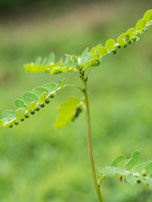SHAHEED KARTAR SINGH SARABHA AYURVEDIC MEDICAL COLLEGE & HOSPITAL
Affiliated to Guru Ravidas Ayurved University, Hoshiarpur Punjab
Affiliated to Guru Ravidas Ayurved University, Hoshiarpur Punjab

Botanical Name : Phyllanthus niruri
Family : Phyllanthaceae
Introduction :
Bhumi amlaki, commonly called as “gale of the wind” is a medicine of choice in various diseases not only in the practice of Ayurveda but also broadly used in other systems of medicines like Unani, Siddha, and Homeopathy. This herb merely not treats diseases but also restores the functions of the organs thus, revives life. But the potential and the main action of this herb is defined on the Liver by our ancient Scholars of Ayurveda.
Names in different Indian languages :
English : Stone breaker
Hindi : Bhui aumvala
Kannada : Nela Nelli
Malayalam : Keezhar Nelli
Sanskrit : Bhumyamalaki
Tamil : Keelanelli or Keezha nelli
Telugu : Nela Usiri
Synonyms :
Tamalaki, jata, vira, uccata
Classification according to Charaka, Susrutha & Vagbhata :
Charaka : Svãsahara, kasahara
Morphology :
It grows 50–70 cm (20–28 in) tall and bears ascending herbaceous branches. The bark is smooth and light green. It bears numerous pale green flowers which are often flushed with red. The fruits are tiny, smooth capsules containing seeds.
Distribution & Habitat :
Phyllanthus niruri is a widespread tropical plant commonly found in coastal areas,
Chemical constituents :
Lignans, flavonoids, triterpenes, sterols, alkaloids, and essential oils are found in this plant
Properties :
RASA- Madhura, tikta, kashaya
GUNA- Laghu, Ruksa
VIRYA- sita
VIPAKA- madhura
Karma : pitta kapha hara
Mutrala, rucya
Indication :
Amlapitta , kasa, rajayaksma, kusta, pandu,prameha, trsna,raktapitta,kamala
Analgesic, antibacterial, antihepatotoxic, anti-inflammatory, antilithic, antimalarial, antimutagenic, antinociceptive, antispasmodic, antiviral, aperitif, carminative, choleretic, deobstruent, digestive, diuretic, febrifuge, hepatotonic, hepatoprotective, hypoglycemic, hypotensive, laxative, stomachic, tonic, vermifuge.
Part used :
Seeds, oil
Dosage :
Powder 2-4 g
External uses :
A poultice of the leaves, combined with salt, is used to treat scabby affection, used without salt it is applied on bruises and wounds
Internal uses :
The root is diuretic and It is used to remove bladder stones, and is a remedy for jaundice
An infusion of the tender fresh roots is valuable in the treatment of chronic dysentery
An infusion of the leaves is used as a treatment for dysentery
The herb is stomachic and useful in the treatment of sores and chronic dysentery
An infusion of the root and leaves is a good tonic and diuretic when taken cold in repeated doses
The milky juice is a good application to treat offensive sores
Important Yogas or Formations : Chyavanaprasha, Jivantyadi Ghrita
